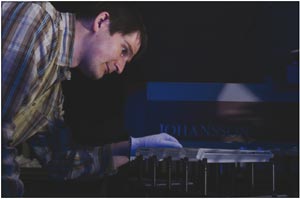The last of the 62,960 lead tungstate crystals arrived at CERN on 9 March, marking the end of a 15 year project for the CMS experiment and the Crystal Clear Collaboration. These crystals will form the 36 supermodules of the barrel electromagnetic calorimeter.

Lead tungstate crystals were chosen because of their high density and ability to stop particles over short distances. In addition, they offer good scintillation properties and radiation hardness. In 1994, the development of the avalanche photodiode detector, which allows small amounts of light to be read in a magnetic field, provided the possibility of using the crystals. By 1998 the Bogoroditsk factory in the Tula region of Russia had begun producing the crystals. The Shanghai Institute of Ceramics in China supplemented this factory in 2005.
Half of the crystals were delivered to the CERN regional centre and the other half to INFN/ENEA. Each crystal underwent strict quality-control where automatic machines measured 67 parameters. There are 1700 crystals in one supermodule of the electromagnetic calorimeter. The first supermodule was inserted in mid-April and the final one should be installed by June 2007.





